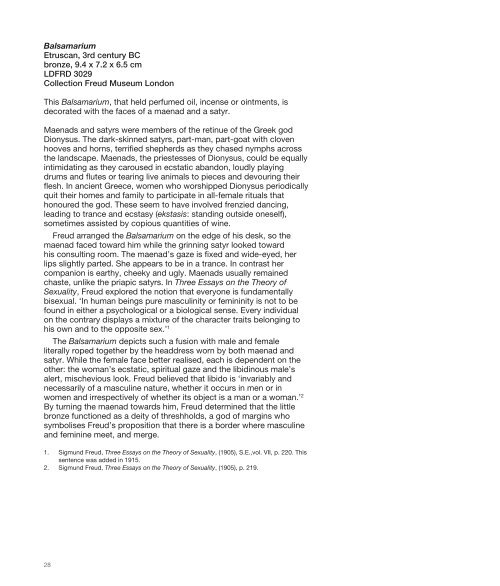sigmund freud's collection an archaeology of the mind
sigmund freud's collection an archaeology of the mind
sigmund freud's collection an archaeology of the mind
Create successful ePaper yourself
Turn your PDF publications into a flip-book with our unique Google optimized e-Paper software.
Balsamarium<br />
Etrusc<strong>an</strong>, 3rd century BC<br />
bronze, 9.4 x 7.2 x 6.5 cm<br />
LDFRD 3029<br />
Collection Freud Museum London<br />
This Balsamarium, that held perfumed oil, incense or ointments, is<br />
decorated with <strong>the</strong> faces <strong>of</strong> a maenad <strong>an</strong>d a satyr.<br />
Maenads <strong>an</strong>d satyrs were members <strong>of</strong> <strong>the</strong> retinue <strong>of</strong> <strong>the</strong> Greek god<br />
Dionysus. The dark-skinned satyrs, part-m<strong>an</strong>, part-goat with cloven<br />
hooves <strong>an</strong>d horns, terrifi ed shepherds as <strong>the</strong>y chased nymphs across<br />
<strong>the</strong> l<strong>an</strong>dscape. Maenads, <strong>the</strong> priestesses <strong>of</strong> Dionysus, could be equally<br />
intimidating as <strong>the</strong>y caroused in ecstatic ab<strong>an</strong>don, loudly playing<br />
drums <strong>an</strong>d fl utes or tearing live <strong>an</strong>imals to pieces <strong>an</strong>d devouring <strong>the</strong>ir<br />
fl esh. In <strong>an</strong>cient Greece, women who worshipped Dionysus periodically<br />
quit <strong>the</strong>ir homes <strong>an</strong>d family to participate in all-female rituals that<br />
honoured <strong>the</strong> god. These seem to have involved frenzied d<strong>an</strong>cing,<br />
leading to tr<strong>an</strong>ce <strong>an</strong>d ecstasy (ekstasis: st<strong>an</strong>ding outside oneself),<br />
sometimes assisted by copious qu<strong>an</strong>tities <strong>of</strong> wine.<br />
Freud arr<strong>an</strong>ged <strong>the</strong> Balsamarium on <strong>the</strong> edge <strong>of</strong> his desk, so <strong>the</strong><br />
maenad faced toward him while <strong>the</strong> grinning satyr looked toward<br />
his consulting room. The maenad’s gaze is fi xed <strong>an</strong>d wide-eyed, her<br />
lips slightly parted. She appears to be in a tr<strong>an</strong>ce. In contrast her<br />
comp<strong>an</strong>ion is earthy, cheeky <strong>an</strong>d ugly. Maenads usually remained<br />
chaste, unlike <strong>the</strong> priapic satyrs. In Three Essays on <strong>the</strong> Theory <strong>of</strong><br />
Sexuality, Freud explored <strong>the</strong> notion that everyone is fundamentally<br />
bisexual. ‘In hum<strong>an</strong> beings pure masculinity or femininity is not to be<br />
found in ei<strong>the</strong>r a psychological or a biological sense. Every individual<br />
on <strong>the</strong> contrary displays a mixture <strong>of</strong> <strong>the</strong> character traits belonging to<br />
his own <strong>an</strong>d to <strong>the</strong> opposite sex.’ 1<br />
The Balsamarium depicts such a fusion with male <strong>an</strong>d female<br />
literally roped toge<strong>the</strong>r by <strong>the</strong> headdress worn by both maenad <strong>an</strong>d<br />
satyr. While <strong>the</strong> female face better realised, each is dependent on <strong>the</strong><br />
o<strong>the</strong>r: <strong>the</strong> wom<strong>an</strong>’s ecstatic, spiritual gaze <strong>an</strong>d <strong>the</strong> libidinous male’s<br />
alert, mischevious look. Freud believed that libido is ‘invariably <strong>an</strong>d<br />
necessarily <strong>of</strong> a masculine nature, whe<strong>the</strong>r it occurs in men or in<br />
women <strong>an</strong>d irrespectively <strong>of</strong> whe<strong>the</strong>r its object is a m<strong>an</strong> or a wom<strong>an</strong>.’ 2<br />
By turning <strong>the</strong> maenad towards him, Freud determined that <strong>the</strong> little<br />
bronze functioned as a deity <strong>of</strong> threshholds, a god <strong>of</strong> margins who<br />
symbolises Freud’s proposition that <strong>the</strong>re is a border where masculine<br />
<strong>an</strong>d feminine meet, <strong>an</strong>d merge.<br />
1. Sigmund Freud, Three Essays on <strong>the</strong> Theory <strong>of</strong> Sexuality, (1905), S.E.,vol. VII, p. 220. This<br />
sentence was added in 1915.<br />
2. Sigmund Freud, Three Essays on <strong>the</strong> Theory <strong>of</strong> Sexuality, (1905), p. 219.<br />
28

















